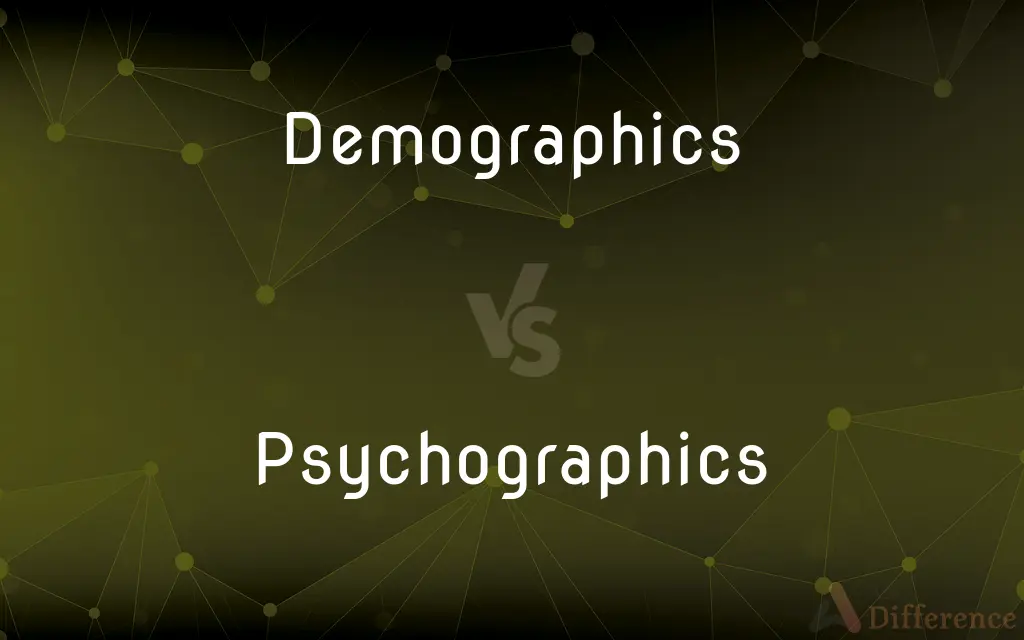Demographics vs. Psychographics — What's the Difference?
By Tayyaba Rehman — Published on October 1, 2023
Demographics pertain to statistical data about populations, like age or income, while psychographics delve into personal attributes such as interests, values, and lifestyles.

Difference Between Demographics and Psychographics
Table of Contents
ADVERTISEMENT
Key Differences
Demographics and psychographics are tools used in market research to understand consumer behavior, but they target different facets of that behavior. Demographics focus on quantifiable population characteristics. This includes age, gender, income level, marital status, occupation, and more. These data points are often used to segment the market and identify target audiences. In contrast, psychographics delve deeper, trying to comprehend the why behind consumer behavior.
Demographics can provide a clear picture of who the target consumer is in terms of hard facts. These are measurable, concrete details that can be easily categorized and quantified. Psychographics, however, offers insights into the more intangible aspects of a consumer. This includes their hobbies, spending habits, values, and even their personality traits.
By understanding demographics, companies can get a snapshot of the size of their potential market, where these consumers are located, and other factual data. Psychographics enhances this by shedding light on consumer motivations, aspirations, and lifestyle choices. This knowledge allows brands to craft more resonant messages and create products that align with consumer desires.
It's important to note that while demographics are largely static, psychographics can evolve over time. A person's age or ethnicity doesn't change, but their interests, values, and lifestyle might. Brands that rely solely on demographic data might miss out on these nuances, emphasizing the importance of considering both in marketing strategies.
Comparison Chart
Type of Data
Quantifiable population characteristics
Personal attributes like values, interests, and lifestyles
ADVERTISEMENT
Examples
Age, gender, income, marital status
Hobbies, spending habits, aspirations, personality traits
Data Stability
Largely static
Can evolve over time
Usage
Market segmentation, target audience identification
Understanding consumer motivations and crafting resonant messages
Source of Data
Census data, surveys, records
Surveys, interviews, focus groups
Compare with Definitions
Demographics
Data points used in market segmentation.
Understanding the demographics helps in tailoring marketing campaigns.
Psychographics
Data about individuals' personality, values, and lifestyles.
The brand relied on psychographics to fine-tune their marketing message.
Demographics
Information about age, income, and other tangible traits.
Their new store caters to the demographics of young professionals.
Psychographics
Insights into consumers' motivations and aspirations.
With psychographics, the company could tailor products to specific desires.
Demographics
Often sourced from census data or surveys.
The recent study provided a detailed breakdown of the region's demographics.
Psychographics
Often sourced from interviews or focus groups.
To get deeper psychographics, the team conducted a series of interviews.
Demographics
Quantifiable metrics about populations.
The demographics of the city have shifted over the past decade.
Psychographics
Helps understand the 'why' behind consumer choices.
While demographics show the 'who', psychographics explain the 'why'.
Demographics
Statistical data relating to a population's characteristics.
Advertisers often use demographics to determine their target audience.
Psychographics
Can change as individuals evolve over time.
People's psychographics can shift, affecting their purchasing decisions.
Demographics
The characteristics of human populations and population segments, especially when used to identify consumer markets
The demographics of the Southwest indicate a growing population of older consumers.
Psychographics
Psychographics is a qualitative methodology used to describe traits of humans on psychological attributes. Psychographics have been applied to the study of personality, values, opinions, attitudes, interests, and lifestyles.
Demographics
The characteristics of human populations for purposes of social studies.
Psychographics
(used with a sing. verb) Demographic research that studies population groups with respect to psychological attributes, such as values or attitudes, as for marketing purposes.
Psychographics
(used with a pl. verb) The data obtained from such research.
Psychographics
The use of demographics to obtain marketing data from people's attitudes, lifestyles etc.
Common Curiosities
Are demographics static or can they change?
Demographics are largely static, such as age or ethnicity.
What can change more frequently, demographics or psychographics?
Psychographics can evolve more frequently as they pertain to interests, values, and lifestyles.
What are some sources of demographic data?
Census data, surveys, and records are common sources for demographics.
Why are both demographics and psychographics important?
While demographics provide a snapshot of the target audience, psychographics enhance understanding of their motivations.
Do psychographics help in predicting consumer behavior?
Yes, psychographics can shed light on consumer motivations, helping predict behavior.
What type of data does demographics provide?
Demographics provide quantifiable data about population characteristics like age, gender, and income.
Can a company rely solely on demographic data?
Relying solely on demographic data might miss nuances in consumer behavior, so it's beneficial to consider psychographics too.
How can companies gather psychographic data?
Companies often use surveys, interviews, and focus groups to gather psychographic insights.
Which is more tangible, demographics or psychographics?
Demographics are more tangible, providing quantifiable data about populations.
How do psychographics differ from demographics?
Psychographics delve into personal attributes like values, interests, and lifestyles, whereas demographics focus on statistical data.
Why are psychographics important in marketing?
Psychographics offer insights into consumer motivations, allowing for more resonant messaging and product alignment.
Which is more specific, demographic or psychographic data?
Psychographic data is more specific as it delves deeper into personal attributes.
Can demographic data help in designing products?
Yes, demographic data can inform about the target audience, aiding product design.
Can psychographics change with life events?
Yes, events like marriage, parenthood, or career changes can influence an individual's psychographics.
How do brands utilize psychographics in advertising?
Brands use psychographics to craft messages that resonate with consumers' values, interests, and lifestyles.
Share Your Discovery

Previous Comparison
Consequence vs. Outcome
Next Comparison
Complain vs. CriticizeAuthor Spotlight
Written by
Tayyaba RehmanTayyaba Rehman is a distinguished writer, currently serving as a primary contributor to askdifference.com. As a researcher in semantics and etymology, Tayyaba's passion for the complexity of languages and their distinctions has found a perfect home on the platform. Tayyaba delves into the intricacies of language, distinguishing between commonly confused words and phrases, thereby providing clarity for readers worldwide.














































